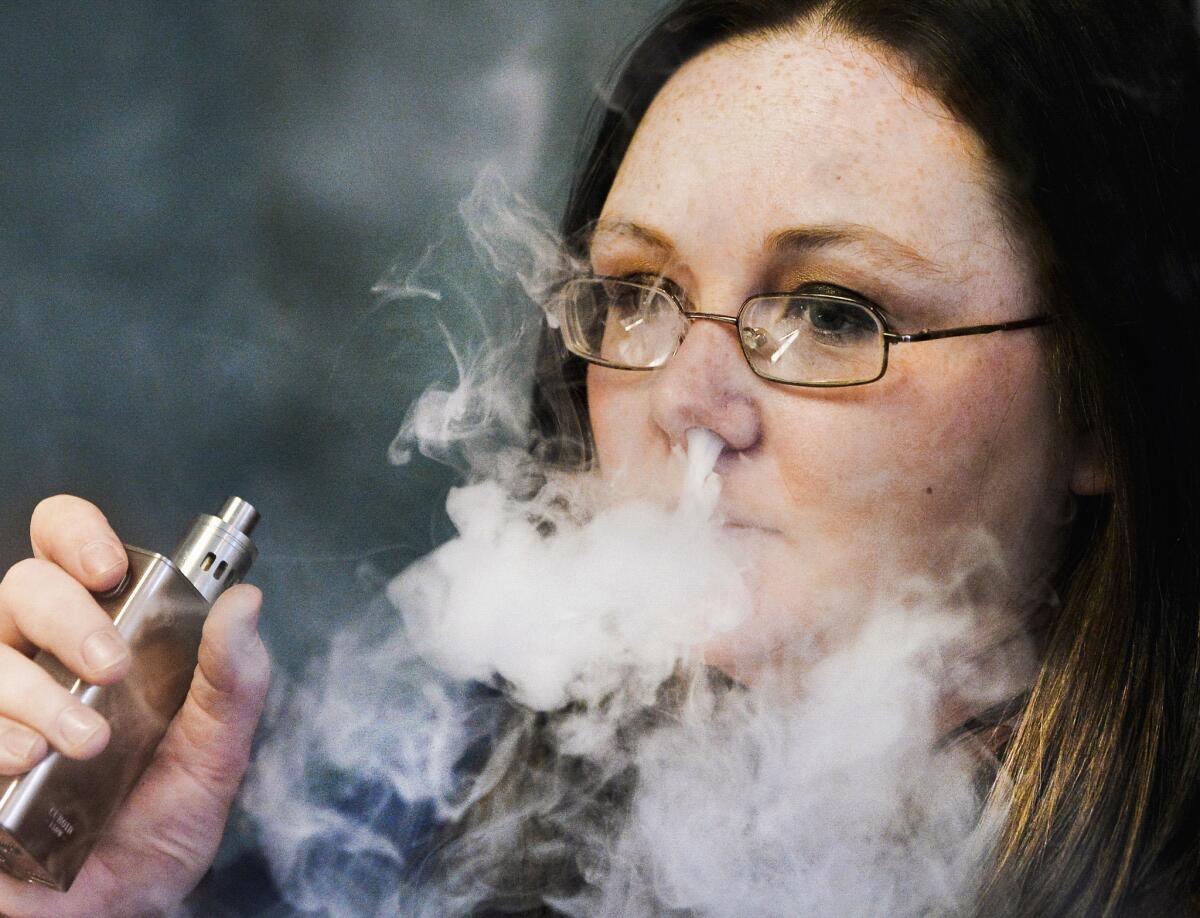Editorial: It’s time to regulate e-cigarettes

An employee at a retail shop that specializes in electronic cigarettes exhales vapor at the store in East Peoria, Ill. on Feb. 17.
- Share via
Exploding hoverboards may have gotten all the attention lately, but electronic cigarettes have also been showing a disturbing tendency to spontaneously combust, injuring a growing number of people whose devices have blown up in their faces or pockets.
Both types of products are powered by rechargeable lithium ion batteries that are suspected of catching fire when overcharged. The self-balancing scooters have caused 52 fires just since December, burning down two homes. Malfunctioning electronic cigarettes, meanwhile, have caused dozens of people to suffer serious burns and disfigurement, and to lose teeth and even fingers. Authorities think cheaply made batteries may be particularly at risk of catching fire.
According to the Centers for Disease Control and Prevention ... use of e-cigarettes has been growing dramatically, tripling among middle and high school students from 2013 to 2014.
The U.S. Consumer Product Safety Commission jumped immediately into action on problem hoverboards, declaring the products an unreasonable fire risk and warning manufacturers to adopt safety standards or face seizures.
E-cigarettes are a different story, however. At the moment, federal regulators can do little more than shake their fists impotently at faulty electronic cigarettes manufacturers, most of whom are in China. That’s because e-cigarettes are considered tobacco products, and thus fall under the authority of the Food and Drug Administration. The FDA has yet to start cracking down despite the meteoric growth of “vaping,” as the process of using an e-cigarette to inhale nicotine is known.
But after four years of work, the agency is close. The FDA sent a final draft of e-cigarette regulations to the White House’s Office of Management and Budget for approval in October, having digested 135,000 comments on the first draft. And there the proposal sits while the fast-growing e-cigarette industry operates virtually unchecked.
Though e-cigarette ignitions are rare relative to the more than 2.5 million Americans who use them, reports of fires and injuries caused by unexpected flare-ups are rising. No one is officially keeping track, so the only indication of frequency is in news reports. A U.S. Fire Administration study found 25 reports of e-cigarette explosions between 2009 and August 2014. So far this year there’s been a story practically every day about a faulty device blowing up.
Although product liability lawsuits have been filed against the retailers and wholesalers, regulations would help stop injuries before they happen by giving the FDA the authority to require the devices to meet federal safety standards. Already it is soliciting public input on e-cigarette problems to have a head start on developing such standards as soon as the new regulations give them the authority to do so.
And though it may take months or longer for product standards to be finalized, the regulations would get the potentially dangerous devices out of the hands of kids immediately. Among other things, the rules would impose the same age restrictions as apply to conventional cigarettes. They can’t come too soon. According to the Centers for Disease Control and Prevention, teen use of e-cigarettes has been growing dramatically, tripling among middle and high school students from 2013 to 2014.
While researchers haven’t yet settled the question of whether vaping is as harmful as smoking, we do know e-cigarette users don’t breathe in the same kind of carcinogenic smoke and tar that conventional cigarette smokers do. That’s good, but it doesn’t make vaping a benign pastime. No matter how you package it, nicotine is an addictive chemical linked to cardiovascular disease.
The vaping liquids have also been found to contain other chemicals such as Diacetyl, a flavoring associated with a terrifying illness called “Popcorn lung.” But until the new regulations kick in and require the disclosure of all chemicals in those liquids, there’s no way for consumers to know what other substances they may be inhaling.
Neither the risk of explosion nor concerns about long-term health effects of e-cigarettes have put a damper on their growing popularity. That makes it all the more imperative to have regulations as soon as possible. We have waited too long already.
Follow the Opinion section on Twitter @latimesopinion and Facebook
A cure for the common opinion
Get thought-provoking perspectives with our weekly newsletter.
You may occasionally receive promotional content from the Los Angeles Times.






